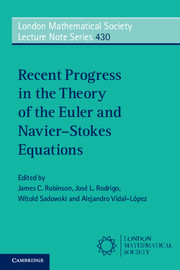Book contents
- Frontmatter
- Dedication
- Contents
- Preface
- List of contributors
- 1 Classical solutions to the two-dimensional Euler equations and elliptic boundary value problems, an overview
- 2 Analyticity radii and the Navier–Stokes equations: recent results and applications
- 3 On the motion of a pendulum with a cavity entirely filled with a viscous liquid
- 4 Modal dependency and nonlinear depletion in the three–dimensional Navier–Stokes equations
- 5 Boussinesq equations with zero viscosity or zero diffusivity: a review
- 6 Global regularity versus finite-time singularities: some paradigms on the effect of boundary conditions and certain perturbations
- 7 Parabolic Morrey spaces and mild solutions of the Navier–Stokes equations. An interesting answer through a silly method to a stupid question
- 8 Well-posedness for the diffusive 3D Burgers equations with initial data in H½
- 9 On the Fursikov approach to the moment problem for the three-dimensional Navier–Stokes equations
- 10 Some probabilistic topics in the Navier–Stokes equations
1 - Classical solutions to the two-dimensional Euler equations and elliptic boundary value problems, an overview
Published online by Cambridge University Press: 05 January 2016
- Frontmatter
- Dedication
- Contents
- Preface
- List of contributors
- 1 Classical solutions to the two-dimensional Euler equations and elliptic boundary value problems, an overview
- 2 Analyticity radii and the Navier–Stokes equations: recent results and applications
- 3 On the motion of a pendulum with a cavity entirely filled with a viscous liquid
- 4 Modal dependency and nonlinear depletion in the three–dimensional Navier–Stokes equations
- 5 Boussinesq equations with zero viscosity or zero diffusivity: a review
- 6 Global regularity versus finite-time singularities: some paradigms on the effect of boundary conditions and certain perturbations
- 7 Parabolic Morrey spaces and mild solutions of the Navier–Stokes equations. An interesting answer through a silly method to a stupid question
- 8 Well-posedness for the diffusive 3D Burgers equations with initial data in H½
- 9 On the Fursikov approach to the moment problem for the three-dimensional Navier–Stokes equations
- 10 Some probabilistic topics in the Navier–Stokes equations
Summary
Abstract
Consider the classical initial, boundary-value problem for the 2D Euler equations, which describes the motion of an ideal, incompressible, fluid in a impermeable vessel. In the early eighties we introduced and studied a Banach space, denoted, which enjoys the following property: if the curl of the initial velocity belongs to, and the curl of the external forces is integrable in time with values in the above space, then all derivatives appearing in the differential equations and in the boundary conditions are continuous in space-time, up to the boundary (we call these solutions classical solutions). At that time this conclusion was know if is replaced by a Hölder space. In the proof of the above result we appealed to a regularity result for solutions to the Poisson equation, vanishing on the boundary and with external forces in. Actually, at that time, we have proved this regularity result for solutions to more general second-order linear elliptic boundaryvalue problems. However the proof remained unpublished. Recently, we have published an adaptation of the proof to solutions of the Stokes system. We recall these results in Section 1.1 below. On the other hand, attempts to prove the above regularity results for data in functional spaces properly containing, have also been done. Bellow we prove some partial results in this direction. This possibly unfinished picture leads to interesting open problems.
The Euler and Stokes equations with data in.
In these notes we want to give an overview on some results, both old and new. Some are old, but remained unpublished for a long time. The starting point will be Beirão da Veiga (1981, 1982, 1984).
We start by introducing some notation. Ω is an open, bounded, connected set in Rn, n ≥ 2, locally situated on one side of its boundary Γ. We assume that Γ is of class, for some positive λ. By we denote the Banach space of all real, continuous functions in with the norm
In the sequel we use the notation
and appeal to the canonical spaces and, with the norms
respectively. Further, for each λ ∈ (0, 1], we define the semi-norm
and the Hölder space, with the norm
In particular, is the space of Lipschitz continuous functions in.
- Type
- Chapter
- Information
- Publisher: Cambridge University PressPrint publication year: 2016
- 1
- Cited by



